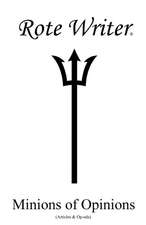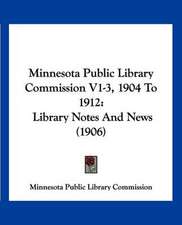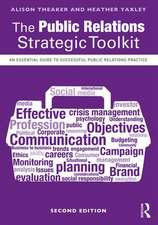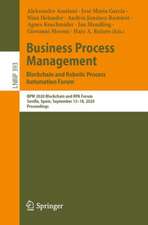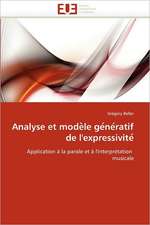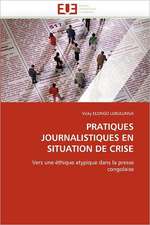Blockchain for Business: IT Principles into Practice
Autor Marco Comuzzi, Paul Grefen, Giovanni Meronien Limba Engleză Paperback – 29 iun 2023
| Toate formatele și edițiile | Preț | Express |
|---|---|---|
| Paperback (1) | 281.77 lei 3-5 săpt. | +24.46 lei 6-12 zile |
| Taylor & Francis – 29 iun 2023 | 281.77 lei 3-5 săpt. | +24.46 lei 6-12 zile |
| Hardback (1) | 769.37 lei 6-8 săpt. | |
| Taylor & Francis – 29 iun 2023 | 769.37 lei 6-8 săpt. |
Preț: 281.77 lei
Nou
Puncte Express: 423
Preț estimativ în valută:
53.92€ • 57.66$ • 44.95£
53.92€ • 57.66$ • 44.95£
Carte disponibilă
Livrare economică 28 martie-11 aprilie
Livrare express 13-19 martie pentru 34.45 lei
Preluare comenzi: 021 569.72.76
Specificații
ISBN-13: 9781032342467
ISBN-10: 1032342463
Pagini: 268
Ilustrații: 29 Tables, black and white; 115 Line drawings, black and white; 115 Illustrations, black and white
Dimensiuni: 174 x 246 x 16 mm
Greutate: 0.5 kg
Ediția:1
Editura: Taylor & Francis
Colecția Routledge
Locul publicării:Oxford, United Kingdom
ISBN-10: 1032342463
Pagini: 268
Ilustrații: 29 Tables, black and white; 115 Line drawings, black and white; 115 Illustrations, black and white
Dimensiuni: 174 x 246 x 16 mm
Greutate: 0.5 kg
Ediția:1
Editura: Taylor & Francis
Colecția Routledge
Locul publicării:Oxford, United Kingdom
Public țintă
Postgraduate, Professional, and Undergraduate AdvancedCuprins
PREFACE
ACKNOWLEDGMENTS
PART 1
CHAPTER 1: A GENTLE INTRODUCTION TO THE WORLD OF BLOCKCHAIN
1.1 WHAT IS BLOCKCHAIN?
1.2 MONEY, TRUST, AND DESIGN CHOICES
1.3 DEFINING BLOCKCHAIN BY EXAMPLE: PLAYING CHESS WITH BLOCKCHAIN
1.3.1 DEFINING AN INITIAL STATE OF A GAME
1.3.2 DEFINING RULES DO DETERMINE VALID MOVES
1.3.3 AN IMMUTABLE DATABASE TO RECORD MOVES
1.3.4 AUTHENTICATING THE PLAYERS
1.4 EXPLORING THE POTENTIAL OF BLOCKCHAIN
1.5 OVERVIEW OF THIS BOOK
1.6 HOW TO USE THIS BOOK
1.7 OVERVIEW OF BLOCKCHAIN APPLICATIONS DISCUSSED IN THIS BOOK
1.8 QUESTIONS AND EXERCISES
CHAPTER 2: CRYPTOGRAPHIC TOOLS FOR BLOCKCHAIN
2.1 COMPUTER-READABLE REPRESENTATION OF DIGITAL MESSAGES
2.1.1 CHARACTER ENCODING
2.1.2 BASE-2 NUMBER REPRESENTATION
2.2 CRYPTOGRAPHIC HASHING
2.2.1 CRYPTOGRAPHIC HASH FUNCTIONS: DEFINITION
2.2.2 APPLICATIONS AND IMPLEMENTATIONS
2.3 MESSAGE ENCRYPTION: SYMMETRIC AND ASYMMETRIC
2.3.1 SYMMETRIC ENCRYPTION: THE CAESAR CYPHER
2.3.2 ASYMMETRIC ENCRYPTION
2.4 DIGITAL SIGNATURES
2.5 CASE STUDY: A BRIEF HISTORY OF CRYPTOGRAPHY
2.6 CONCLUSIONS
2.7 QUESTIONS AND EXERCISES
CHAPTER 3: AN IMPLEMENTATION-AGNOSTIC DEFINITION OF BLOCKCHAIN
3.1 WHAT IS BLOCKCHAIN?
3.2 BLOCKCHAIN AS A P2P NETWORK
3.2.1 WHAT IS A USER OF A BLOCKCHAIN NETWORK?
3.2.2 PUBLIC AND PRIVATE BLOCKCHAIN NETWORKS
3.3 DATA MANAGEMENT IN A BLOCKCHAIN NODE: TRANSACTIONS AND IMMUTABLE DATABASES
3.3.1 IMPLEMENTING DATA IMMUTABILITY BY DESIGN
3.4 CONSENSUS MECHANISM
3.5 A MORE PRECISE SPECIFICATION OF BC4C
3.6 CASE STUDY: THE PREDECESSORS OF BITCOIN
3.7 CONCLUSIONS
3.8 QUESTIONS AND EXERCISES
CHAPTER 4: EXTENDING BLOCKCHAIN WITH SMART CONTRACTS
4.1 THE CASE FOR EXTENDING BLOCKCHAIN WITH BUSINESS LOGIC
4.2 PROPERTIES OF SMART CONTRACTS
4.3 ON-CHAIN, OFF-CHAIN DATA, AND SMART CONTRACT ORACLES
4.4 AN ARCHITECTURE FOR BLOCKCHAIN SYSTEMS
4.5 CASE STUDY: THE ORIGINAL DEFINITION OF SMART CONTRACT
4.6 CONCLUSIONS
4.7 QUESTIONS AND EXERCISES
PART 2
CHAPTER 5: BITCOIN AND PUBLIC BLOCKCHAIN
5.1 THE BITCOIN NETWORK
5.2 BITCOIN TRANSACTIONS
5.2.1 TRANSACTIONS AND NODE BALANCES IN BITCOIN
5.2.2 DIGITAL SIGNATURE OF BITCOIN TRANSACTIONS
5.3 BITCOIN BLOCKCHAIN AS A DATA STRUCTURE: THE BITCOIN LEDGER
5.4 BITCOIN CONSENSUS MECHANISM
5.4.1 THE LIFE CYCLE OF BITCOIN TRANSACTIONS
5.4.2 CREATING A NEW BLOCK
5.4.3 CALCULATING A CORRECT NONCE FOR A CANDIDATE NEW BLOCK
5.5 CASE STUDY: BITCOIN IN THE REAL WORLD
5.6 CONCLUSIONS
5.7 QUESTIONS AND EXERCISES
CHAPTER 6: ETHEREUM AND SMART CONTRACT-ENABLED BLOCKCHAIN
6.1 ETHEREUM NETWORK
6.2 ETHEREUM TRANSACTIONS
6.2.1 TRANSACTIONS TRANSFERRING ETHEREUM TOKENS BETWEEN EOAS
6.2.2 SMART CONTRACT-RELATED TRANSACTIONS
6.3 ETHEREUM LEDGER AND CONSENSUS MECHANISM: THE ETHEREUM VIRTUAL MACHINE
6.4 ETHEREUM CONSENSUS MECHANISM
6.5 ETHEREUM SMART CONTRACTS AND TOKENS
6.5.1 SMART CONTRACTS
6.5.2 ETHEREUM TOKENS
6.6 ETHEREUM DISTRIBUTED APPLICATIONS (DAPPS)
6.7 CASE STUDY – EVERLEDGER: SECURE PROVENANCE IN SUPPLY CHAINS OVER ETHEREUM
6.8 CONCLUSIONS
6.9 QUESTIONS AND EXERCISES
CHAPTER 7: PRIVATE BLOCKCHAIN
7.1 CHARACTERIZING THE PRIVATE BLOCKCHAIN
7.2 ETHEREUM AS A PRIVATE BLOCKCHAIN
7.3 CORDA: PRIVATE BLOCKCHAIN BASED ON A NEED-TO-KNOW LEDGER
7.3.1 CORDA DATA STRUCTURE
7.3.2 CORDA NETWORK AND CONSENSUS MECHANISM
7.4 HYPERLEDGER FABRIC: SMART CONTRACT-ENABLED PRIVATE BLOCKCHAIN
7.4.1 HYPERLEDGER FABRIC DATA STRUCTURES
7.4.2 HYPERLEDGER FABRIC NETWORK AND CONSENSUS MECHANISM
7.5 CASE STUDY: REAL WORLD APPLICATIONS THAT USE CORDA AND HYPERLEDGER FABRIC
7.6 CONCLUSIONS
7.7 QUESTIONS AND EXERCISES
CHAPTER 8: BLOCKCHAIN AND THE INTERNET OF THINGS
8.1 WHAT IS THE IOT?
8.2 FOUNDATIONS OF THE IOT
8.2.1 RADIO FREQUENCY IDENTIFICATION (RFID)
8.2.2 WIRELESS SENSOR AND ACTUATOR NETWORK (WSAN)
8.3 APPLICATIONS FOR THE IOT
8.3.1 LOGISTICS
8.3.2 HEALTHCARE
8.3.3 MANUFACTURING
8.3.4 SMART CITIES
8.3.5 SUSTAINABLE ENERGY
8.4 COMBINING THE IOT WITH BLOCKCHAIN
8.5 CHALLENGES IN BLOCKCHAIN-BASED IOT PLATFORMS
8.5.1 LATENCY
8.5.2 VOLUME
8.5.3 COMPUTING POWER
8.5.4 STORAGE REQUIREMENTS
8.6 IOTA: A DLT FOR THE IOT
8.6.1 IOTA 2.0
8.6.2 IOTA STREAMS
8.6.3 IOTA APPLICATIONS IN THE IOT
8.7 IMPLEMENTING IOT APPLICATIONS WITH EXISTING BLOCKCHAINS
8.7.1 BITCOIN
8.7.2 ETHEREUM
8.7.3 HYPERLEDGER FABRIC
8.8 CASE STUDY: SECURE ARTIFACT-DRIVEN PROCESS MONITORING
8.9 CONCLUSIONS
8.10 QUESTIONS AND EXERCISES
PART 3
CHAPTER 9: SUITABILITY OF BUSINESS SCENARIOS FOR BLOCKCHAIN
9.1 STRUCTURING THE DECISION OF ADOPTING BLOCKCHAIN
9.2 BUSINESS SUITABILITY OF BLOCKCHAIN
9.2.1 MULTI-PARTY
9.2.2 TRUSTED AUTHORITY
9.2.3 CENTRALIZED OPERATION
9.2.4 IMMUTABILITY
9.3 TECHNICAL SUITABILITY OF BLOCKCHAIN
9.3.1 DATA SIZE
9.3.2 PERFORMANCE
9.3.3 COST
9.3.4 TRANSPARENCY
9.4 APPLYING THE DECISION MAKING TOOLS
9.4.1 SAFE DISPOSAL OF INDUSTRIAL WASTE
9.4.2 MANAGEMENT OF ELECTRONIC HEALTH RECORDS
9.4.3 SELF-SOVEREIGN IDENTITY MANAGEMENT
9.5 CONCLUSIONS
9.6 QUESTIONS AND EXERCISES
CHAPTER 10: BLOCKCHAIN AND BUSINESS MODELS
10.1 WHAT IS A BUSINESS MODEL?
10.1.1 THE BUSINESS MODEL CONCEPT
10.1.2 SPECIFYING BUSINESS MODELS INSIDE-OUT
10.1.3 SPECIFYING BUSINESS MODELS OUTSIDE-IN
10.2 BUSINESS MODELS IN THE DIGITAL AGE
10.2.1 DIGITALLY SUPPORTED BUSINESS MODELS
10.2.2 DIGITALLY ENABLED BUSINESS MODELS
10.2.3 TYPES OF E-BUSINESS MODELS AND BLOCKCHAIN
10.3 BLOCKCHAIN AS AN EFFICIENCY BOOSTER
10.3.1 THE NEED FOR EFFICIENCY
10.3.2 TRADITIONAL CERTIFIED SPARE PARTS MARKETS
10.3.3 BLOCKCHAIN-BOOSTED CERTIFIED SPARE PARTS MARKETS
10.4 BLOCKCHAIN AS A BUSINESS TRUST ENABLER
10.4.1 THE ROLE OF TRUST IN (ELECTRONIC) BUSINESS
10.4.2 TRADITIONAL MULTI-MODAL LOGISTIC MARKETS
10.4.3 BLOCKCHAIN-BASED, MULTI-MODAL LOGISTICS MARKETS
10.5 BLOCKCHAIN AS A DISINTERMEDIATOR
10.5.1 THE CONCEPT OF DISINTERMEDIATION
10.5.2 THE REAL ESTATE BUSINESS DOMAIN CASE
10.6 DESIGNING BLOCKCHAIN-ENABLED BUSINESS MODELS
10.6.1 TECHNOLOGY-PUSH BUSINESS MODEL DESIGN
10.6.1 USING FUNCTIONAL CHARACTERISTICS OF BLOCKCHAIN TECHNOLOGY
10.6.2 USING NON-FUNCTIONAL CHARACTERISTICS OF BLOCKCHAIN TECHNOLOGY
10.6.3 REQUIREMENTS-PULL BUSINESS MODEL DESIGN
10.7 CONCLUSIONS
10.8 QUESTIONS AND EXERCISES
CHAPTER 11: BLOCKCHAIN IN OUTCOME MANAGEMENT
11.1 THE OUTCOME ECONOMY CONCEPT
11.2 AN OUTCOME ECONOMY CONTROL MODEL
11.2.1 ORGANIZATION-LEVEL BUSINESS CONTROL MODEL
11.2.2 CHAIN-LEVEL BUSINESS OUTCOME CONTROL LEVEL
11.3 TRUST MANAGEMENT IN OUTCOME-BASED BUSINESS
11.3.1 THE NEED FOR TRUST
11.3.2 TRUST MANAGEMENT WITH BLOCKCHAIN
11.4 DATA PROCESSING IN OUTCOME MANAGEMENT
11.4.1 OUTCOME DATA PROCESSING
11.4.2 TYPES OF SENSORS
11.4.3 TYPES OF REGULATORS
11.4.4 FEDERATED DATA PROCESSING
11.5 A CASE STUDY IN SEA CONTAINER TRANSPORT
11.5.1 CASE OUTLINE
11.5.2 CONCEPTUAL MODEL WITH ONE CUSTOMER
11.5.3 TECHNICAL MODEL WITH ONE CUSTOMER
11.5.4 EXTENDING THE MODEL TO MULTIPLE CUSTOMERS
11.5.5 PLACING THE TECHNOLOGY IN THE REFERENCE ARCHITECTURE
11.6 BUSINESS MODEL DESIGN FOR OUTCOME MANAGEMENT
11.6.1 CHOOSING A BUSINESS MODEL SPECIFICATION TECHNIQUE
11.6.2 AN EXAMPLE BUSINESS MODEL FOR THE SEA CONTAINER CASE
11.7 CONCLUSIONS
11.8 QUESTIONS AND EXERCISES
REFERENCES
INDEX
ACKNOWLEDGMENTS
PART 1
CHAPTER 1: A GENTLE INTRODUCTION TO THE WORLD OF BLOCKCHAIN
1.1 WHAT IS BLOCKCHAIN?
1.2 MONEY, TRUST, AND DESIGN CHOICES
1.3 DEFINING BLOCKCHAIN BY EXAMPLE: PLAYING CHESS WITH BLOCKCHAIN
1.3.1 DEFINING AN INITIAL STATE OF A GAME
1.3.2 DEFINING RULES DO DETERMINE VALID MOVES
1.3.3 AN IMMUTABLE DATABASE TO RECORD MOVES
1.3.4 AUTHENTICATING THE PLAYERS
1.4 EXPLORING THE POTENTIAL OF BLOCKCHAIN
1.5 OVERVIEW OF THIS BOOK
1.6 HOW TO USE THIS BOOK
1.7 OVERVIEW OF BLOCKCHAIN APPLICATIONS DISCUSSED IN THIS BOOK
1.8 QUESTIONS AND EXERCISES
CHAPTER 2: CRYPTOGRAPHIC TOOLS FOR BLOCKCHAIN
2.1 COMPUTER-READABLE REPRESENTATION OF DIGITAL MESSAGES
2.1.1 CHARACTER ENCODING
2.1.2 BASE-2 NUMBER REPRESENTATION
2.2 CRYPTOGRAPHIC HASHING
2.2.1 CRYPTOGRAPHIC HASH FUNCTIONS: DEFINITION
2.2.2 APPLICATIONS AND IMPLEMENTATIONS
2.3 MESSAGE ENCRYPTION: SYMMETRIC AND ASYMMETRIC
2.3.1 SYMMETRIC ENCRYPTION: THE CAESAR CYPHER
2.3.2 ASYMMETRIC ENCRYPTION
2.4 DIGITAL SIGNATURES
2.5 CASE STUDY: A BRIEF HISTORY OF CRYPTOGRAPHY
2.6 CONCLUSIONS
2.7 QUESTIONS AND EXERCISES
CHAPTER 3: AN IMPLEMENTATION-AGNOSTIC DEFINITION OF BLOCKCHAIN
3.1 WHAT IS BLOCKCHAIN?
3.2 BLOCKCHAIN AS A P2P NETWORK
3.2.1 WHAT IS A USER OF A BLOCKCHAIN NETWORK?
3.2.2 PUBLIC AND PRIVATE BLOCKCHAIN NETWORKS
3.3 DATA MANAGEMENT IN A BLOCKCHAIN NODE: TRANSACTIONS AND IMMUTABLE DATABASES
3.3.1 IMPLEMENTING DATA IMMUTABILITY BY DESIGN
3.4 CONSENSUS MECHANISM
3.5 A MORE PRECISE SPECIFICATION OF BC4C
3.6 CASE STUDY: THE PREDECESSORS OF BITCOIN
3.7 CONCLUSIONS
3.8 QUESTIONS AND EXERCISES
CHAPTER 4: EXTENDING BLOCKCHAIN WITH SMART CONTRACTS
4.1 THE CASE FOR EXTENDING BLOCKCHAIN WITH BUSINESS LOGIC
4.2 PROPERTIES OF SMART CONTRACTS
4.3 ON-CHAIN, OFF-CHAIN DATA, AND SMART CONTRACT ORACLES
4.4 AN ARCHITECTURE FOR BLOCKCHAIN SYSTEMS
4.5 CASE STUDY: THE ORIGINAL DEFINITION OF SMART CONTRACT
4.6 CONCLUSIONS
4.7 QUESTIONS AND EXERCISES
PART 2
CHAPTER 5: BITCOIN AND PUBLIC BLOCKCHAIN
5.1 THE BITCOIN NETWORK
5.2 BITCOIN TRANSACTIONS
5.2.1 TRANSACTIONS AND NODE BALANCES IN BITCOIN
5.2.2 DIGITAL SIGNATURE OF BITCOIN TRANSACTIONS
5.3 BITCOIN BLOCKCHAIN AS A DATA STRUCTURE: THE BITCOIN LEDGER
5.4 BITCOIN CONSENSUS MECHANISM
5.4.1 THE LIFE CYCLE OF BITCOIN TRANSACTIONS
5.4.2 CREATING A NEW BLOCK
5.4.3 CALCULATING A CORRECT NONCE FOR A CANDIDATE NEW BLOCK
5.5 CASE STUDY: BITCOIN IN THE REAL WORLD
5.6 CONCLUSIONS
5.7 QUESTIONS AND EXERCISES
CHAPTER 6: ETHEREUM AND SMART CONTRACT-ENABLED BLOCKCHAIN
6.1 ETHEREUM NETWORK
6.2 ETHEREUM TRANSACTIONS
6.2.1 TRANSACTIONS TRANSFERRING ETHEREUM TOKENS BETWEEN EOAS
6.2.2 SMART CONTRACT-RELATED TRANSACTIONS
6.3 ETHEREUM LEDGER AND CONSENSUS MECHANISM: THE ETHEREUM VIRTUAL MACHINE
6.4 ETHEREUM CONSENSUS MECHANISM
6.5 ETHEREUM SMART CONTRACTS AND TOKENS
6.5.1 SMART CONTRACTS
6.5.2 ETHEREUM TOKENS
6.6 ETHEREUM DISTRIBUTED APPLICATIONS (DAPPS)
6.7 CASE STUDY – EVERLEDGER: SECURE PROVENANCE IN SUPPLY CHAINS OVER ETHEREUM
6.8 CONCLUSIONS
6.9 QUESTIONS AND EXERCISES
CHAPTER 7: PRIVATE BLOCKCHAIN
7.1 CHARACTERIZING THE PRIVATE BLOCKCHAIN
7.2 ETHEREUM AS A PRIVATE BLOCKCHAIN
7.3 CORDA: PRIVATE BLOCKCHAIN BASED ON A NEED-TO-KNOW LEDGER
7.3.1 CORDA DATA STRUCTURE
7.3.2 CORDA NETWORK AND CONSENSUS MECHANISM
7.4 HYPERLEDGER FABRIC: SMART CONTRACT-ENABLED PRIVATE BLOCKCHAIN
7.4.1 HYPERLEDGER FABRIC DATA STRUCTURES
7.4.2 HYPERLEDGER FABRIC NETWORK AND CONSENSUS MECHANISM
7.5 CASE STUDY: REAL WORLD APPLICATIONS THAT USE CORDA AND HYPERLEDGER FABRIC
7.6 CONCLUSIONS
7.7 QUESTIONS AND EXERCISES
CHAPTER 8: BLOCKCHAIN AND THE INTERNET OF THINGS
8.1 WHAT IS THE IOT?
8.2 FOUNDATIONS OF THE IOT
8.2.1 RADIO FREQUENCY IDENTIFICATION (RFID)
8.2.2 WIRELESS SENSOR AND ACTUATOR NETWORK (WSAN)
8.3 APPLICATIONS FOR THE IOT
8.3.1 LOGISTICS
8.3.2 HEALTHCARE
8.3.3 MANUFACTURING
8.3.4 SMART CITIES
8.3.5 SUSTAINABLE ENERGY
8.4 COMBINING THE IOT WITH BLOCKCHAIN
8.5 CHALLENGES IN BLOCKCHAIN-BASED IOT PLATFORMS
8.5.1 LATENCY
8.5.2 VOLUME
8.5.3 COMPUTING POWER
8.5.4 STORAGE REQUIREMENTS
8.6 IOTA: A DLT FOR THE IOT
8.6.1 IOTA 2.0
8.6.2 IOTA STREAMS
8.6.3 IOTA APPLICATIONS IN THE IOT
8.7 IMPLEMENTING IOT APPLICATIONS WITH EXISTING BLOCKCHAINS
8.7.1 BITCOIN
8.7.2 ETHEREUM
8.7.3 HYPERLEDGER FABRIC
8.8 CASE STUDY: SECURE ARTIFACT-DRIVEN PROCESS MONITORING
8.9 CONCLUSIONS
8.10 QUESTIONS AND EXERCISES
PART 3
CHAPTER 9: SUITABILITY OF BUSINESS SCENARIOS FOR BLOCKCHAIN
9.1 STRUCTURING THE DECISION OF ADOPTING BLOCKCHAIN
9.2 BUSINESS SUITABILITY OF BLOCKCHAIN
9.2.1 MULTI-PARTY
9.2.2 TRUSTED AUTHORITY
9.2.3 CENTRALIZED OPERATION
9.2.4 IMMUTABILITY
9.3 TECHNICAL SUITABILITY OF BLOCKCHAIN
9.3.1 DATA SIZE
9.3.2 PERFORMANCE
9.3.3 COST
9.3.4 TRANSPARENCY
9.4 APPLYING THE DECISION MAKING TOOLS
9.4.1 SAFE DISPOSAL OF INDUSTRIAL WASTE
9.4.2 MANAGEMENT OF ELECTRONIC HEALTH RECORDS
9.4.3 SELF-SOVEREIGN IDENTITY MANAGEMENT
9.5 CONCLUSIONS
9.6 QUESTIONS AND EXERCISES
CHAPTER 10: BLOCKCHAIN AND BUSINESS MODELS
10.1 WHAT IS A BUSINESS MODEL?
10.1.1 THE BUSINESS MODEL CONCEPT
10.1.2 SPECIFYING BUSINESS MODELS INSIDE-OUT
10.1.3 SPECIFYING BUSINESS MODELS OUTSIDE-IN
10.2 BUSINESS MODELS IN THE DIGITAL AGE
10.2.1 DIGITALLY SUPPORTED BUSINESS MODELS
10.2.2 DIGITALLY ENABLED BUSINESS MODELS
10.2.3 TYPES OF E-BUSINESS MODELS AND BLOCKCHAIN
10.3 BLOCKCHAIN AS AN EFFICIENCY BOOSTER
10.3.1 THE NEED FOR EFFICIENCY
10.3.2 TRADITIONAL CERTIFIED SPARE PARTS MARKETS
10.3.3 BLOCKCHAIN-BOOSTED CERTIFIED SPARE PARTS MARKETS
10.4 BLOCKCHAIN AS A BUSINESS TRUST ENABLER
10.4.1 THE ROLE OF TRUST IN (ELECTRONIC) BUSINESS
10.4.2 TRADITIONAL MULTI-MODAL LOGISTIC MARKETS
10.4.3 BLOCKCHAIN-BASED, MULTI-MODAL LOGISTICS MARKETS
10.5 BLOCKCHAIN AS A DISINTERMEDIATOR
10.5.1 THE CONCEPT OF DISINTERMEDIATION
10.5.2 THE REAL ESTATE BUSINESS DOMAIN CASE
10.6 DESIGNING BLOCKCHAIN-ENABLED BUSINESS MODELS
10.6.1 TECHNOLOGY-PUSH BUSINESS MODEL DESIGN
10.6.1 USING FUNCTIONAL CHARACTERISTICS OF BLOCKCHAIN TECHNOLOGY
10.6.2 USING NON-FUNCTIONAL CHARACTERISTICS OF BLOCKCHAIN TECHNOLOGY
10.6.3 REQUIREMENTS-PULL BUSINESS MODEL DESIGN
10.7 CONCLUSIONS
10.8 QUESTIONS AND EXERCISES
CHAPTER 11: BLOCKCHAIN IN OUTCOME MANAGEMENT
11.1 THE OUTCOME ECONOMY CONCEPT
11.2 AN OUTCOME ECONOMY CONTROL MODEL
11.2.1 ORGANIZATION-LEVEL BUSINESS CONTROL MODEL
11.2.2 CHAIN-LEVEL BUSINESS OUTCOME CONTROL LEVEL
11.3 TRUST MANAGEMENT IN OUTCOME-BASED BUSINESS
11.3.1 THE NEED FOR TRUST
11.3.2 TRUST MANAGEMENT WITH BLOCKCHAIN
11.4 DATA PROCESSING IN OUTCOME MANAGEMENT
11.4.1 OUTCOME DATA PROCESSING
11.4.2 TYPES OF SENSORS
11.4.3 TYPES OF REGULATORS
11.4.4 FEDERATED DATA PROCESSING
11.5 A CASE STUDY IN SEA CONTAINER TRANSPORT
11.5.1 CASE OUTLINE
11.5.2 CONCEPTUAL MODEL WITH ONE CUSTOMER
11.5.3 TECHNICAL MODEL WITH ONE CUSTOMER
11.5.4 EXTENDING THE MODEL TO MULTIPLE CUSTOMERS
11.5.5 PLACING THE TECHNOLOGY IN THE REFERENCE ARCHITECTURE
11.6 BUSINESS MODEL DESIGN FOR OUTCOME MANAGEMENT
11.6.1 CHOOSING A BUSINESS MODEL SPECIFICATION TECHNIQUE
11.6.2 AN EXAMPLE BUSINESS MODEL FOR THE SEA CONTAINER CASE
11.7 CONCLUSIONS
11.8 QUESTIONS AND EXERCISES
REFERENCES
INDEX
Notă biografică
Marco Comuzzi is Associate Professor and Director of the Blockchain Research Center at the Ulsan National Institute of Science and Technology in Korea since 2016.
Paul Grefen is Senior Full Professor at Eindhoven University of Technology in the Netherlands since 2003 and a Principal Architect at Eviden Digital Transformation Consulting since 2020.
Giovanni Meroni is Assistant Professor at Technical University of Denmark (DTU) since 2022.
Paul Grefen is Senior Full Professor at Eindhoven University of Technology in the Netherlands since 2003 and a Principal Architect at Eviden Digital Transformation Consulting since 2020.
Giovanni Meroni is Assistant Professor at Technical University of Denmark (DTU) since 2022.
Descriere
This book gives readers the tools to understand the full extent to which blockchain technology is or can be used in business.

